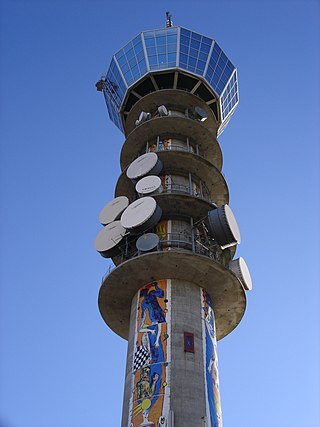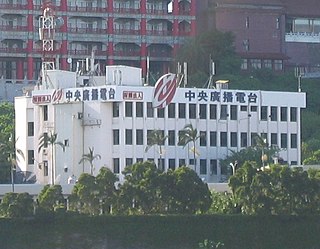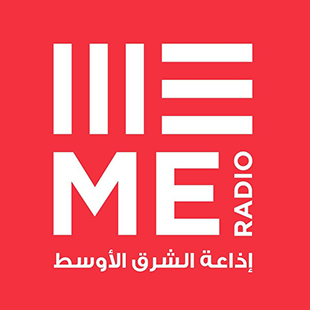Related Research Articles

Radio broadcasting is the broadcasting of audio (sound), sometimes with related metadata, by radio waves to radio receivers belonging to a public audience. In terrestrial radio broadcasting the radio waves are broadcast by a land-based radio station, while in satellite radio the radio waves are broadcast by a satellite in Earth orbit. To receive the content the listener must have a broadcast radio receiver (radio). Stations are often affiliated with a radio network that provides content in a common radio format, either in broadcast syndication or simulcast, or both. Radio stations broadcast with several different types of modulation: AM radio stations transmit in AM, FM radio stations transmit in FM, which are older analog audio standards, while newer digital radio stations transmit in several digital audio standards: DAB, HD radio, DRM. Television broadcasting is a separate service that also uses radio frequencies to broadcast television (video) signals.
In-band on-channel (IBOC) is a hybrid method of transmitting digital radio and analog radio broadcast signals simultaneously on the same frequency. The name refers to the new digital signals being broadcast in the same AM or FM band (in-band), and associated with an existing radio channel (on-channel). By utilizing additional digital subcarriers or sidebands, digital information is "multiplexed" on existing signals, thus avoiding re-allocation of the broadcast bands.
A subcarrier is a sideband of a radio frequency carrier wave, which is modulated to send additional information. Examples include the provision of colour in a black and white television system or the provision of stereo in a monophonic radio broadcast. There is no physical difference between a carrier and a subcarrier; the "sub" implies that it has been derived from a carrier, which has been amplitude modulated by a steady signal and has a constant frequency relation to it.

The FM broadcast band is a range of radio frequencies used for FM broadcasting by radio stations. The range of frequencies used differs between different parts of the world. In Europe and Africa and in Australia and New Zealand, it spans from 87.5 to 108 megahertz (MHz) - also known as VHF Band II - while in the Americas it ranges from 88 to 108 MHz. The FM broadcast band in Japan uses 76 to 95 MHz, and in Brazil, 76 to 108 MHz. The International Radio and Television Organisation (OIRT) band in Eastern Europe is from 65.9 to 74.0 MHz, although these countries now primarily use the 87.5 to 108 MHz band, as in the case of Russia. Some other countries have already discontinued the OIRT band and have changed to the 87.5 to 108 MHz band.
Near Instantaneous Companded Audio Multiplex (NICAM) is an early form of lossy compression for digital audio. It was originally developed in the early 1970s for point-to-point links within broadcasting networks. In the 1980s, broadcasters began to use NICAM compression for transmissions of stereo TV sound to the public.

China Radio International (CRI) is the state-owned international radio broadcaster of China. It is currently headquartered in the Babaoshan area of Beijing's Shijingshan District. It was founded on December 3, 1941, as Radio Peking. It later adopted the pinyin form Radio Beijing.

Beijing Radio and Television Station (BRTV), formerly Beijing Media Network (BMN), is a government-owned television network in China. It broadcasts from Beijing. The channel is available only in Chinese. Broadcasts in Beijing are on AM, FM, cable FM, digital radio, digital TV and online.

FM broadcasting is a method of radio broadcasting that uses frequency modulation (FM) of the radio broadcast carrier wave. Invented in 1933 by American engineer Edwin Armstrong, wide-band FM is used worldwide to transmit high-fidelity sound over broadcast radio. FM broadcasting offers higher fidelity—more accurate reproduction of the original program sound—than other broadcasting techniques, such as AM broadcasting. It is also less susceptible to common forms of interference, having less static and popping sounds than are often heard on AM. Therefore, FM is used for most broadcasts of music and general audio. FM radio stations use the very high frequency range of radio frequencies.
Subsidiary Communications Authorization (SCA) in the United States, and Subsidiary Communications Multiplex Operation (SCMO) in Canada, is a subcarrier on a radio station, allowing the station to broadcast additional services as part of its signal.
Radio enjoys a huge following in the United Kingdom. There are around 600 licensed radio stations in the country. For a more comprehensive list see List of radio stations in the United Kingdom.

Radio Taiwan International is the English name and call sign of the Central Broadcasting System (CBS), national broadcaster and international radio service of Taiwan. It is a government-owned station that broadcasts in 14 languages around the world via the internet, shortwave and podcasts. It also has Facebook fan pages in five additional languages. The station’s hosts and programs have won many national and global broadcasting awards.

CHIN is a commercial AM radio station in Toronto, Ontario, Canada. It is owned by CHIN Radio/TV International, and broadcasts a multilingual radio format, with programs in Mandarin, Cantonese, Portuguese and other languages. It formerly utilized an FM rebroadcaster at 91.9 MHz, CHIN-1-FM, originally used to fill in reception gaps in parts of Greater Toronto; CHIN-1-FM now broadcasts a separate schedule of ethnic programming, no longer simulcasting CHIN. In addition, there is a full-power FM station on 100.7 MHz, CHIN-FM, which offers a third ethnic programme schedule. CHIN, CHIN-1-FM and CHIN-FM have their radio studios on College Street in the Palmerston-Little Italy neighbourhood of Toronto.

CHKG-FM is a commercial radio station in Vancouver, British Columbia, Canada. It airs talk and music programs in multiple languages, with Chinese languages shows after 3 p.m. on weekdays, including Mandarin and Cantonese. It is owned by the Fairchild Group. The studios are at Aberdeen Centre in Richmond.

CHOU is a multilingual Canadian radio station broadcasting in Montreal, Quebec at 1450 kHz and retransmitted at 104.5 MHz. The main programming is in Arabic language and caters for various Arab and Middle Eastern communities in Greater Montreal and vicinity in Arabic including Lebanese, Syrian, Egyptian and Maghrebi dialects. CHOU also runs a two-hour weekly show in Armenian. It is also offered online and on various applications.
CAPITAL 958 (城市頻道) is a Mandarin news and information station operating in Singapore, managed by Mediacorp. It was the only Mandarin radio station in Singapore before the officially introduction of its sister channel such as YES 933 and Love 972 on 1 January 1990 and 23 September 1994 respectively. The station mainly provides local and international news, current affairs, in depth analysis interviews into different key topics and playing of Mandarin hits. It also broadcasts news daily in other languages including Hokkien, Teochew, Cantonese, Hainanese, Hakka and Fuzhounese on selected timings from Monday to Sunday. During weekends, listeners could also look forward to songs from the 1950s, 1960s and 1970s.

Voice of Han Broadcasting Station also known as Voice of Han Chinese Broadcasting Station was founded in 1942 by the Ministry of National Defense. It is headquartered on Xinyi Road in the Zhongzheng District of Taipei, Taiwan.
KBS Radio 2 is a K-Pop, classical music, and entertainment network of the Korean Broadcasting System. Opened in 1933 on AM Radio, the network began utilising FM Radio frequencies 67 years later for a clearer audio reception.
Voice of the Strait, Founded on August 24, 1958. the predecessor is the PLA Fujian Front Line Broadcasting Station (中国人民解放军福建前线广播电台), established in Yuandang Street No. 15, Gulou District, Fuzhou city, Fujian province, People's Republic of China. is composed of People's Liberation Army opened stations, mainly for the Taiwan radio, broadcast radio the Mandarin and Minnan language dialect program, now has 5 broadcast channels, also set up Chinese classical network radio. The platform is provided with the official website of the network.
Chinese Voice is a Cantonese, Mandarin and English language radio network based in Auckland, New Zealand. It is a wholly owned subsidiary of Best News Entertainment, an Asian language television, print and radio company, and consists of three station set up between 2003 and 2010. It produces more than 80 hours of local content each week, including live talkback on news stories, migrant issues, political developments and dealing with New Zealand Government agencies. The stations also broadcast imported talk and music programmes from China and Hong Kong.
References
- ↑ "Rfi - 波长和频率". Archived from the original on 2007-07-04. Retrieved 2007-07-04.
- ↑ "德国之声英文节目 | DW". Dw-world.de. Retrieved 2018-08-14.
- ↑ "Radio Romania International". Archived from the original on 2008-12-18. Retrieved 2008-12-22.
- ↑ "俄罗斯之声". Archived from the original on 2007-09-15. Retrieved 2007-07-04.
- ↑ "Spectrum Radio International AM558 - 倫敦國際廣播電台". Archived from the original on 2007-07-04. Retrieved 2007-07-09.
- ↑ "BBC 中文网 | 广播节目表 | 星期一". Archived from the original on 2007-05-23. Retrieved 2007-07-04.
- ↑ "BBC Manchester - Chinatown - BBC GMR - Eastern Horizon". Bbc.co.uk. 1983-12-15. Retrieved 2018-08-14.
- ↑ "BBC Radio Merseyside - Orient Express". Bbc.co.uk. 2018-01-31. Retrieved 2018-08-14.
- ↑ "Unity 101 - Under The Same Sky".
- ↑ "Vatican Radio - Audio on demand". Archived from the original on 2007-07-15. Retrieved 2007-07-04.
- ↑ "Archived copy". Archived from the original on 2012-08-24. Retrieved 2013-10-29.
{{cite web}}: CS1 maint: archived copy as title (link)